The Challenges of Building the Largest Projects on Earth
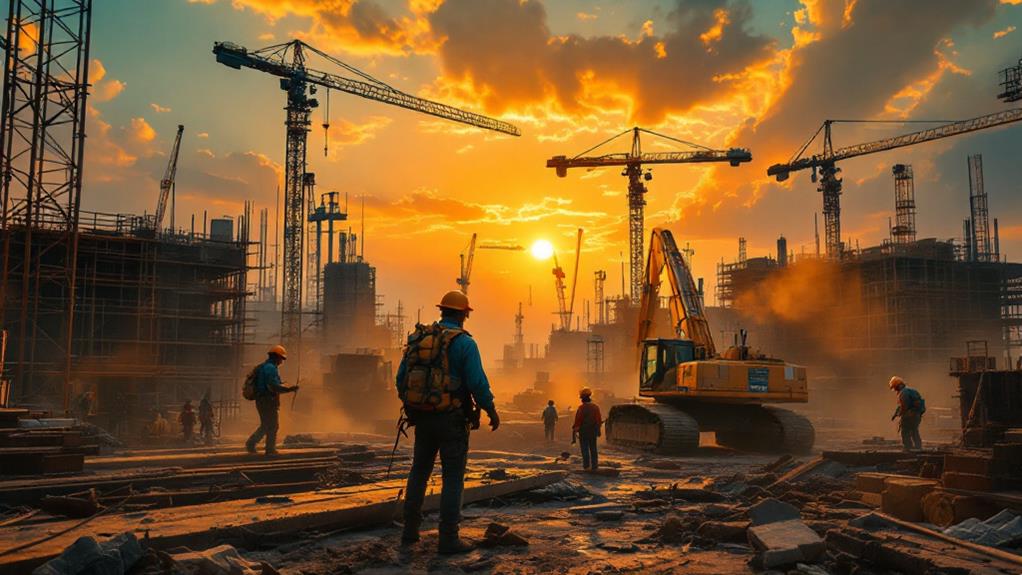
When tackling the largest projects on Earth, you're maneuvering complex engineering challenges and logistical nightmares. Projects like the Burj Khalifa and Great Man-Made River require creative solutions to handle extreme environmental conditions and vast resource management. In these ventures, collaboration across nations is key, as seen with the International Space Station, overcoming significant health and safety concerns. Furthermore, balancing environmental concerns with ambitious construction goals adds another layer of complexity. These challenges highlight the importance of pushing boundaries while ensuring sustainable practices. Exploring further will reveal the intricacies and triumphs behind these colossal endeavors.
Architectural Marvels and Their Costs
With regard to architectural marvels, their staggering costs often reflect the complexity and ambition of these projects. Take the Burj Khalifa, for instance. Completed in 2010, it stands as the world's tallest building, costing $1.5 billion. This ambitious project required 22 million man-hours and a deep foundation supported by 192 piles. Such construction projects often symbolize economic growth, showcasing a region's ability to push engineering limits. Likewise, Beijing's Daxing International Airport, designed by Zaha Hadid, opened in 2019 with a whopping $17 billion price tag. Its starfish-shaped terminal efficiently handles over 100 million passengers annually, further illustrating the economic potential these marvels can reveal.
However, these architectural marvels can also raise environmental concerns. The Great Man-Made River project in Libya, with a budget of $25 billion, spans an impressive 2,820 kilometers, supplying 70% of Libya's freshwater. While it addresses water scarcity, the project's environmental impact is significant. Meanwhile, Saudi Arabia's NEOM City project aims for sustainability with its $500 billion budget, blending advanced infrastructure and eco-friendly technologies. As you consider these projects, their costs highlight the intricate balance between ambitious construction and the environmental implications they pose.
Infrastructure Innovations and Delays
While architectural marvels impress with their grandeur and cost, the true assessment of a project's success often lies in the creative solutions needed to overcome delays and challenges. Take the Burj Khalifa, for instance. You'd think the extreme heat would halt progress, but engineers devised with reflective glazing and textured stainless steel to guarantee comfort and structural integrity. Such adaptability is essential in engineering projects, where delays can drive up costs considerably.
The Gotthard Base Tunnel is another demonstration of human ingenuity. Over 17 years, engineers tackled safety and ventilation challenges by excavating millions of tons of rock. This persistence in construction highlights the dedication required to complete these expensive undertakings.
In terms of water management, the Great Man-Made River project in Libya showcases the complexities of accessing water in arid regions. Drilling over 1,300 wells into the Nubian Sandstone aquifer wasn't just a feat of engineering; it was a necessity for survival.
Even on an international scale, like the ISS, intricate logistics and collaborative efforts from multiple countries addressed delays and technical hurdles. These projects underline the significance of inventive solutions, regardless of tapping into renewable energy or overcoming natural obstacles.
Environmental Considerations in Construction
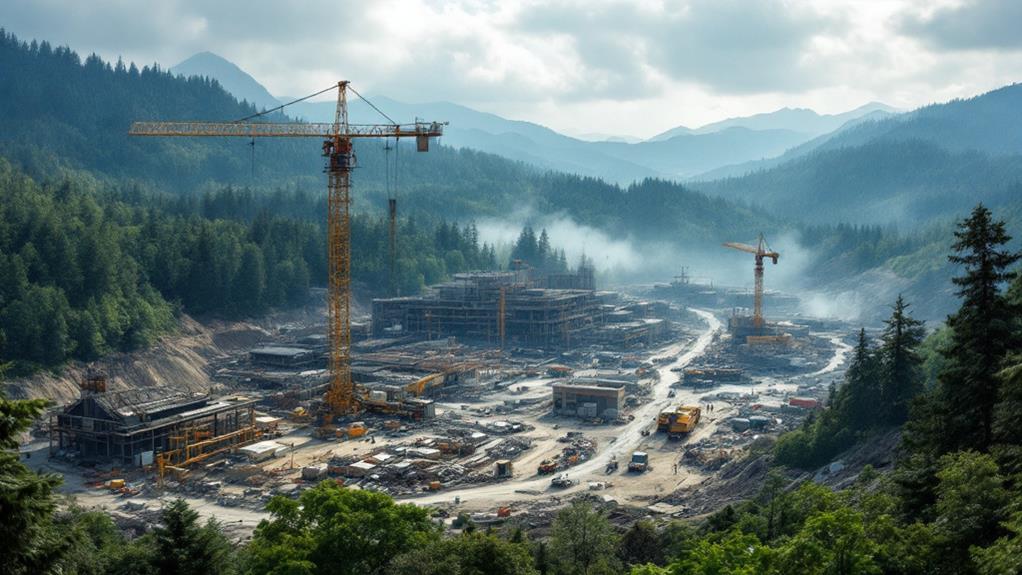
The towering silhouette of the Burj Khalifa isn't just an architectural marvel; it exemplifies how modern construction can adapt to harsh environmental conditions. By using reflective glazing and textured stainless steel cladding, the building effectively tackles extreme heat, a prime example of addressing environmental challenges in construction. As you consider the complexities of such projects, it's essential to think about the sustainable measures implemented to guarantee these structures can withstand and thrive in their environments.
Take the NEOM City Project, for instance. It's designed to rely entirely on renewable energy, setting a sustainability benchmark. By integrating transportation networks, it minimizes environmental impact, showcasing forward-thinking in construction projects. Meanwhile, the Great Man-Made River in Libya highlights the geological challenges faced in sourcing water supply. Over 1,300 wells were drilled to access the Nubian Sandstone aquifer, illustrating the extensive efforts required to obtain freshwater in arid regions.
When considering safety and environmental health, large-scale projects like the Gotthard Base Tunnel confront geological challenges, assuring ventilation and safety during construction. Even the Panama Canal overcame environmental health hurdles, addressing tropical diseases to protect workers, proving that environmental considerations are integral to successful construction projects.
Overcoming Engineering Obstacles
Engineering obstacles in large-scale projects test human ingenuity and resilience like few other challenges do. Take the Gotthard Base Tunnel, where overcoming engineering obstacles meant tackling severe geological challenges. You'd excavate millions of tons of rock to carve out the world's longest and deepest railway tunnel. The project required not just brute force but precision and adaptability in the face of unpredictable geological shifts.
In Libya, the Great Man-Made River project addressed water scarcity by drilling over 1,300 wells into the Nubian Sandstone aquifer. Here, groundbreaking engineering solutions were vital for accessing freshwater and overcoming geological challenges. The Burj Khalifa's construction in Dubai faced extreme heat. You'd need to use reflective glazing and textured stainless steel to keep the building cool, while a robust foundation of 192 piles guaranteed stability.
The Panama Canal's builders faced not just engineering, but health challenges from tropical diseases. You had to develop groundbreaking solutions to protect workers and push the project forward. Furthermore, the International Space Station's assembly involved complex logistical challenges. You'd orchestrate an international effort to assemble its parts in space, a demonstration of overcoming obstacles with creativity and collaboration.
Global Collaboration and Coordination
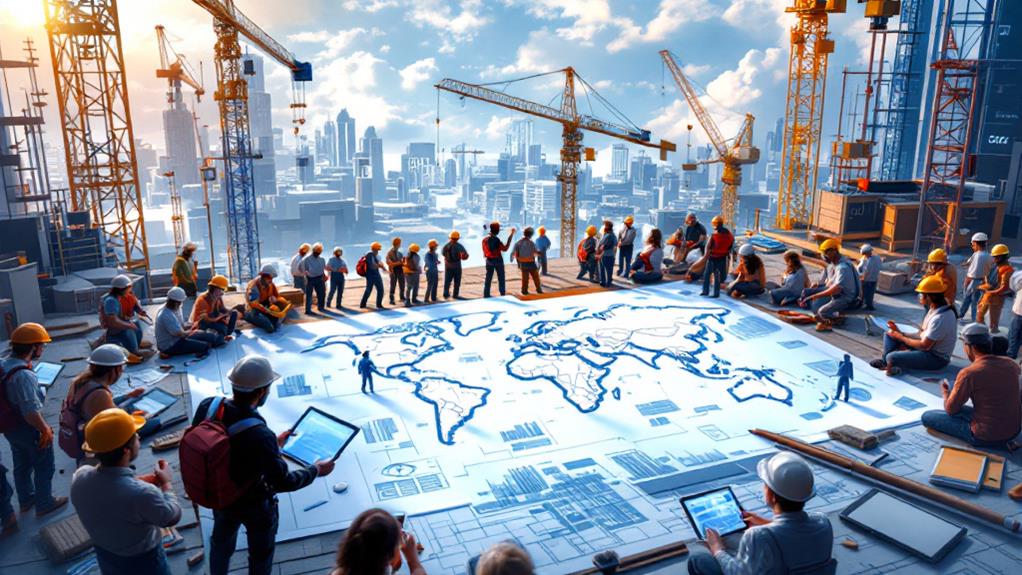
Global collaboration and coordination form the backbone of successful large-scale projects. Imagine the International Space Station (ISS), a marvel of global collaboration involving space agencies like NASA and Roscosmos. Here, international partners from five countries unite, maneuvering complex logistics to build a $150 billion project piece by piece in space. Each module, starting with Russia's launch, highlights the intricate dance of international teamwork.
Similarly, China's South-North Water Transfer Project showcases extensive collaboration across regions to tackle water scarcity. With an estimated completion date by 2050, this project demonstrates how complex logistics and coordination are vital in achieving sustainability initiatives on a monumental scale. It mirrors the international partnership seen in the historic Panama Canal project, where groundbreaking engineering overcame tropical diseases and worker safety challenges, proving that coordinated efforts between nations can surmount even the toughest obstacles.
Looking to the future, the NEOM City Project in Saudi Arabia epitomizes global coordination with its ambitious $500 billion vision. This project integrates advanced technologies and sustainability initiatives, aligning with Vision 2030. As you can see, these projects illustrate the power and necessity of international collaboration and coordination in building the world's largest and most creative ventures.
Technological Integration in Projects
In the present rapidly evolving world, integrating technology into large-scale projects is vital for success and efficiency. Technological innovation plays a significant role in overcoming complex logistics and geological challenges. For instance, the REBIM® Construction Management Tool improves digital collaboration, ensuring efficient management of construction processes and documentation. This tool exemplifies how technology streamlines project management from inception to completion.
Consider the Burj Khalifa, where advanced materials like reflective glazing and textured stainless steel cladding address extreme heat, showcasing innovation in construction techniques. Such materials are important in ensuring structures withstand environmental challenges while maintaining aesthetic appeal. Likewise, the Great Man-Made River in Libya demonstrates technology's role in overcoming geological challenges. By drilling over 1,300 wells, engineers accessed the Nubian Sandstone aquifer, highlighting how technological solutions can tackle natural obstacles.
The International Space Station's assembly required cutting-edge engineering and complex logistics, emphasizing technological innovation in international collaboration. Finally, Beijing's Daxing International Airport, with its starfish-shaped terminal, utilizes advanced construction techniques to accommodate over 100 million passengers. These examples illustrate how technology is indispensable in executing and managing the largest projects on Earth, ensuring they meet modern demands efficiently and effectively.
Resource Management Challenges
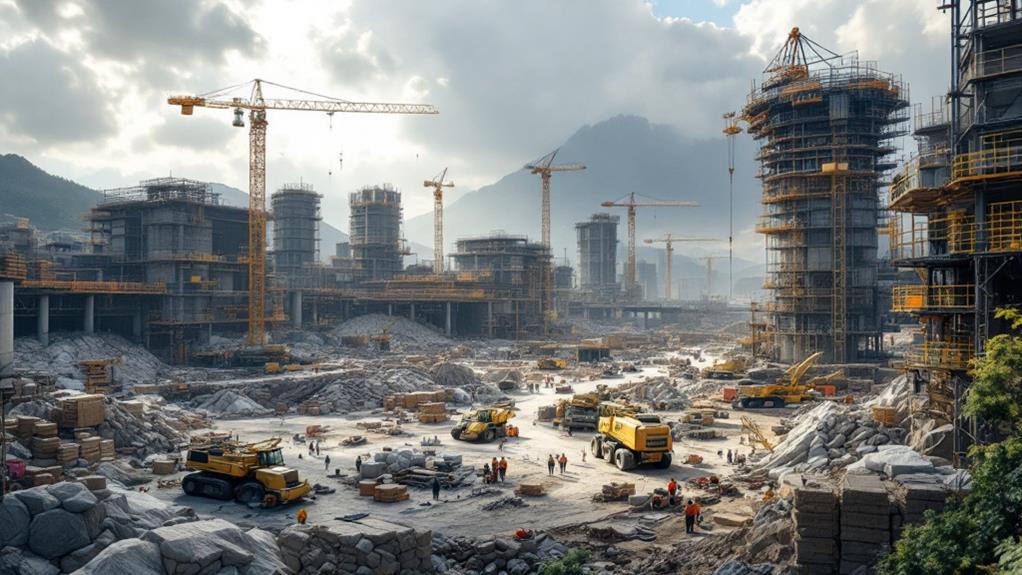
Amidst the complexities of large-scale projects, managing resources efficiently is paramount to their success. Take the Great Man-Made River project in Libya, for example. It faced the intimidating task of overcoming water scarcity by drilling over 1,300 wells into the Nubian Sandstone aquifer. This resource management effort was crucial to supply 70% of the country's freshwater. Likewise, the Jubail Industrial City project in Saudi Arabia tackled construction challenges in the harsh Arabian Desert environment, requiring a monthly workforce of 20,000 skilled workers. Such immense labor demand highlights the significant resource management needed to sustain development.
When you look at the Panama Canal, worker safety was a major concern. Tropical diseases threatened labor availability, prompting groundbreaking health measures. These measures were vital to maintain a steady workforce and guarantee the project's success. Meanwhile, China's South-North Water Transfer Project aims to combat water scarcity through a vast network of tunnels and canals, planned for completion by 2050. Finally, Saudi Arabia's NEOM City Project showcases sustainable resource management. By integrating renewable energy across its 26,500 square kilometers, it exemplifies future-forward planning in large-scale construction. Each project underscores the critical importance of resource management in overcoming construction challenges.
Adapting to Extreme Conditions
Extreme conditions challenge even the most seasoned engineers and architects when building ambitious projects. When constructing the Burj Khalifa, you have to tackle extreme temperatures, which can warp materials. The solution? Reflective glazing and textured stainless steel cladding help keep those temperatures in check. In Libya, the Great Man-Made River project demands drilling over 1,300 wells in harsh desert conditions. You dig deep—500 meters—to tap into the Nubian Sandstone aquifer, battling relentless heat and aridity.
Meanwhile, NEOM City in Saudi Arabia presents its own set of challenges. You must design buildings that can withstand extreme temperatures and sandstorms. The focus on renewable energy sources guarantees these structures remain sustainable and resilient. The Panama Canal's construction story is a lesson in overcoming more than just environmental challenges. Tropical diseases were a major hurdle, prompting creative health measures to safeguard workers and maintain progress.
Socio-Economic Impacts on Communities
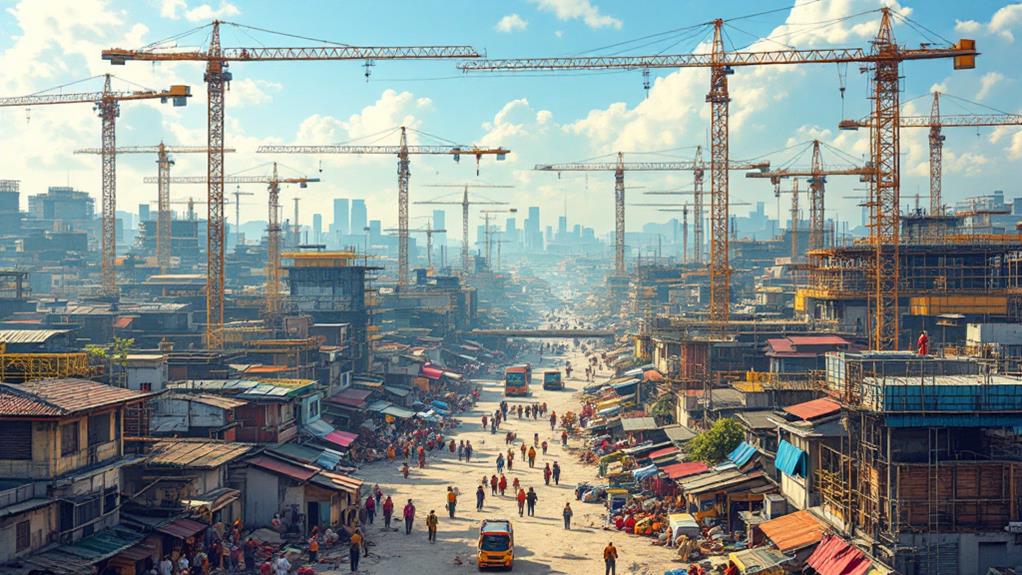
While massive projects can reshape landscapes, they also bring profound socio-economic changes to the communities they touch. Imagine living in a region transformed by a giant undertaking like Jubail Industrial City, which provides jobs for around 20,000 people every month. These jobs can uplift millions by greatly contributing to local economies and even national GDP, as seen with Jubail, which accounts for approximately 7% of Saudi Arabia's GDP.
In Libya, the Great Man-Made River stands as a symbol of how crucial water sources can change lives. By supplying 70% of the country's freshwater, it supports both agricultural and domestic needs, ensuring that communities thrive where water scarcity once reigned. Likewise, the Panama Canal's expansion has had notable socio-economic impacts, improving global trade and elevating Panama's economy, with the canal contributing about 8% to the nation's GDP.
Projects in major cities, like the Burj Khalifa in Dubai, draw tourists and generate revenue, while NEOM City's green energy initiatives aim to create sustainable urban environments. These projects not only improve quality of life but also attract global investment, benefiting countless communities.
Future Prospects of Mega Projects
As we consider the socio-economic impacts of past projects, it's essential to look ahead at the future prospects of mega projects. These vast undertakings promise to reshape our world, addressing pressing challenges like carbon emissions and resource management. The NEOM City Project in Saudi Arabia, with its $500 billion budget, is set to redefine sustainability standards by relying entirely on renewable energy. It's a glimpse into how future projects in the world might tackle carbon emissions head-on.
In California, the High-Speed Rail Line aims to revolutionize intercity travel, cutting travel time between San Francisco and Los Angeles to just 2.5 hours. Such projects highlight a shift towards efficient transportation that could greatly reduce carbon footprints. Meanwhile, the expansion of Al Maktoum International Airport focuses on doubling capacity to meet growing air traffic demands, showcasing the need for improved global connectivity.
In places facing resource scarcity, groundbreaking solutions like Libya's Great Man-Made River, which delivers 70% of the country's freshwater, demonstrate how mega projects can secure water for millions. As you consider these examples, it's evident that the future prospects of mega projects hold transformative potential for addressing global challenges.



